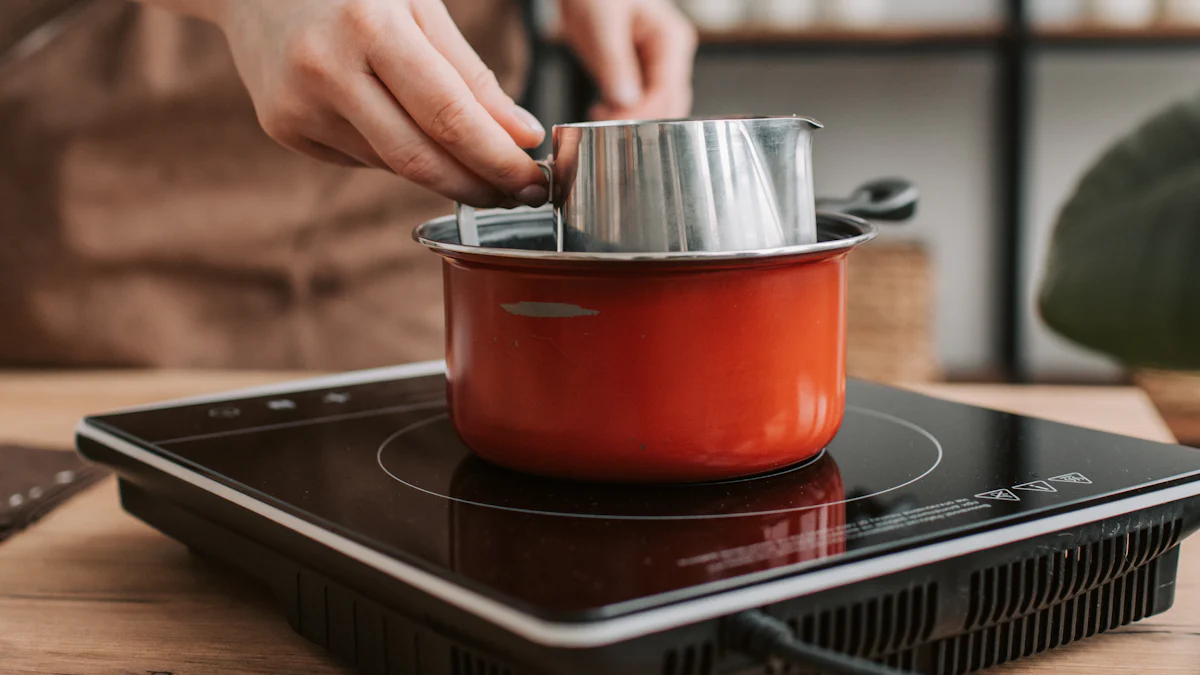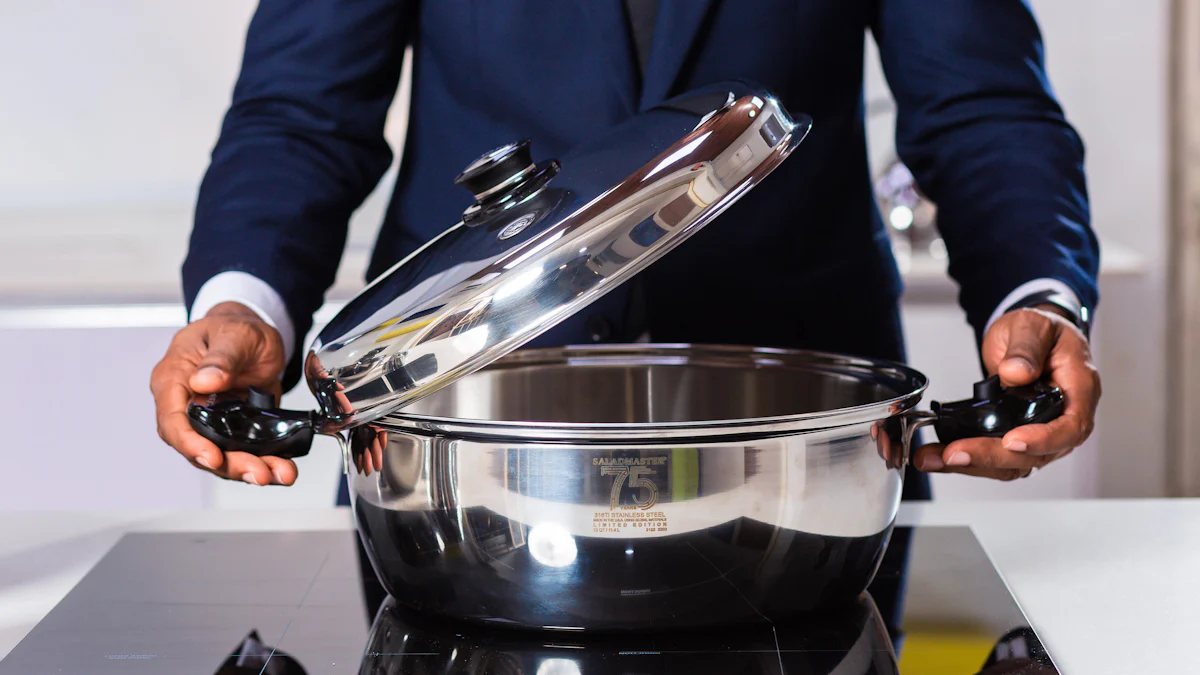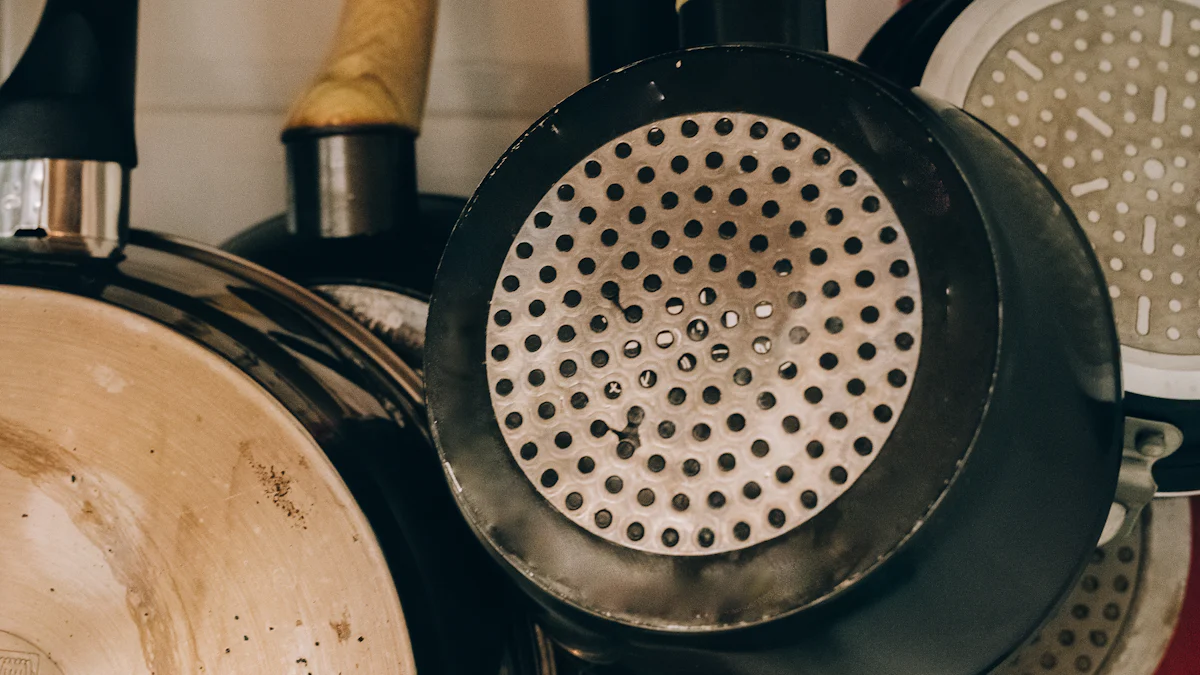Top Induction Disks for Cookware Compared

Induction cooking has revolutionized modern kitchens with its efficiency and precision. However, not all cookware is compatible with induction cooktops, which rely on magnetic fields to generate heat. This is where an induction disk for cookware becomes indispensable. These disks act as a bridge, enabling non-induction pots and pans to function seamlessly on induction stoves. Made from durable materials like stainless steel, they ensure even heat distribution. While induction disks may not match the energy efficiency of direct induction-compatible cookware, they provide a practical solution for extending the usability of existing kitchen tools.
Key Takeaways
- Induction disks allow non-induction cookware to work on induction cooktops, extending the usability of your existing pots and pans.
- Choose an induction disk that matches the size of your cookware for optimal heat distribution and efficiency.
- Consider the weight of the induction disk; heavier disks retain heat better, while lighter ones offer portability but may compromise performance.
- High-quality materials like stainless steel and aluminum enhance heat transfer efficiency and durability, ensuring long-term use.
- Compatibility is key: ensure your cookware is flat-bottomed and avoid warped or oversized pots to maximize cooking results.
- Budget-friendly options like the VonShef Induction Hob Heat Diffuser provide good value, while premium models like the Mauviel disk offer superior craftsmanship.
- Always follow manufacturer guidelines for safe use to prevent damage to both the induction disk and your cooktop.
What to Look for in an Induction Disk for Cookware
Choosing the right induction disk for cookware requires careful consideration of several factors. Each aspect plays a crucial role in ensuring optimal performance and compatibility with your kitchen setup.
Compatibility with Cookware
Types of cookware that work with induction disks
Induction disks function as a bridge between non-induction cookware and induction cooktops. They are particularly effective with cookware made from materials like aluminum, copper, or glass, which lack magnetic properties. Flat-bottomed pots and pans perform best, as they ensure even contact with the disk’s surface. Stainless steel and cast iron cookware, though already induction-compatible, can also benefit from induction disks in specific scenarios, such as when additional heat diffusion is needed.
“An induction disk is a flat disk that sits on the surface of an induction cooktop and gets heated by the element, becoming a hot cooking surface.”
This design allows users to extend the functionality of their existing cookware without investing in entirely new sets.
Common compatibility issues to avoid
Not all cookware pairs seamlessly with induction disks. Uneven or warped bottoms can reduce heat transfer efficiency, leading to inconsistent cooking results. Additionally, oversized pots may extend beyond the disk’s surface, causing uneven heating. Users should also avoid using cookware with delicate coatings, as prolonged exposure to high heat from the disk may damage these surfaces. Ensuring a snug fit between the cookware and the disk minimizes these issues and maximizes performance.
Dimensions and Weight
Why size matters for heat distribution
The size of an induction disk directly impacts its ability to distribute heat evenly. A disk that matches the diameter of the cookware ensures consistent heating across the entire surface. Smaller disks may create hot spots, while larger ones may waste energy by heating areas not in contact with the cookware. Selecting the right size enhances cooking precision and reduces energy consumption.
Balancing weight and portability
Weight plays a significant role in the usability of an induction disk. Heavier disks, often made from thicker stainless steel, provide better heat retention and durability. However, they may be cumbersome to handle, especially for frequent use. Lightweight options offer greater portability but may compromise on heat retention and stability. Striking a balance between weight and functionality ensures a practical and efficient cooking experience.
Performance and Durability
Heat transfer efficiency
The primary function of an induction disk is to transfer heat efficiently from the induction cooktop to the cookware. High-quality disks achieve this by using materials with excellent thermal conductivity, such as stainless steel or aluminum cores. These materials minimize heat loss and ensure rapid, even heating. Studies have shown that well-designed induction systems can achieve high levels of efficiency, with minimal discrepancies between theoretical and experimental performance.
Materials used and their impact on longevity
The durability of an induction disk depends on the materials used in its construction. Stainless steel, known for its resistance to corrosion and wear, is a popular choice. Some disks incorporate aluminum layers to enhance heat conductivity. Disks with multi-layered designs often last longer and maintain consistent performance over time. Investing in a disk made from high-quality materials ensures long-term reliability and reduces the need for frequent replacements.
Top Induction Disks for Cookware Reviewed

Product 1: Max Burton Induction Interface Disk
Key features and specifications
The Max Burton 6010 8-Inch Induction Interface Disk stands out for its durable stainless-steel construction. Measuring 15 x 8 x 0.5 inches and weighing 3 pounds, this disk offers a robust and reliable solution for non-induction cookware. It includes a heat-proof handle, ensuring safe handling during cooking. The set provides versatility with three sizes: 6-inch, 8-inch, and 10-inch disks, making it an excellent alternative to purchasing a completely new set of induction-ready pots and pans.
“This induction disk is designed to bridge the gap between traditional cookware and modern induction cooktops, offering convenience and efficiency.”
Customer reviews and ratings
Users frequently praise the Max Burton disk for its consistent heat transfer and sturdy build. Many appreciate its ability to work seamlessly with various cookware types, including aluminum and copper. However, some reviews mention that its weight may feel cumbersome for extended use. Overall, it receives high ratings for performance and durability.
Pros and cons
Pros:
- Durable stainless-steel construction.
- Heat-proof handle for safety.
- Multiple size options for versatility.
Cons:
- Heavier than some competitors.
- May take longer to heat compared to direct induction cookware.
Product 2: Mauviel Interface Induction Disk
Key features and specifications
The Mauviel M’plus 7500.00 Interface Disc is renowned for its premium quality and precision. Designed for low-temperature use, it ensures optimal performance without overheating. This disk is compatible with a wide range of cookware materials, making it a versatile addition to any kitchen. Its sleek design and high-quality construction reflect Mauviel’s commitment to excellence.
“Always use the interface disc on a low temperature,” advises Mauviel, emphasizing the importance of controlled heat for longevity and performance.
Customer reviews and ratings
Customers often highlight the Mauviel disk’s superior craftsmanship and compatibility with delicate cookware. Its ability to maintain consistent heat at lower temperatures makes it ideal for slow cooking and simmering. Some users note that the low-temperature restriction may limit its versatility for high-heat cooking.
Pros and cons
Pros:
- High-quality construction.
- Ideal for low-temperature cooking.
- Compatible with various cookware types.
Cons:
- Not suitable for high-heat applications.
- Higher price point compared to other options.
Product 3: VonShef Induction Hob Heat Diffuser
Key features and specifications
The VonShef Induction Hob Heat Diffuser offers an affordable solution for those seeking an induction disk for cookware. Its lightweight design ensures easy handling, while its aluminum core enhances heat distribution. This disk is particularly effective for simmering sauces and melting chocolate, where precise temperature control is essential.
“The VonShef diffuser provides an economical way to adapt non-induction cookware for induction stoves without compromising on performance.”
Customer reviews and ratings
Many users commend the VonShef disk for its budget-friendly price and reliable performance. Its lightweight nature makes it easy to store and transport. However, some reviews mention that it may not retain heat as effectively as heavier disks, which could impact cooking times.
Pros and cons
Pros:
- Affordable price.
- Lightweight and portable.
- Good for low-heat cooking tasks.
Cons:
- Limited heat retention.
- May not be as durable as premium options.
Product 4: Norpro Heat Diffuser
Key features and specifications
The Norpro Heat Diffuser offers a practical solution for those seeking a lightweight and portable induction disk for cookware. Constructed from durable stainless steel, this disk ensures even heat distribution, making it ideal for simmering sauces or cooking delicate dishes. Its perforated design enhances heat diffusion, preventing hot spots and ensuring consistent results. The disk measures approximately 8 inches in diameter, making it compatible with a wide range of cookware sizes. A heat-resistant handle adds convenience, allowing users to safely move the disk during cooking.
“The Norpro Heat Diffuser is designed to protect cookware from direct heat, ensuring gentle and even cooking.”
This feature makes it particularly suitable for tasks requiring precise temperature control, such as melting chocolate or preparing custards.
Customer reviews and ratings
Users frequently commend the Norpro Heat Diffuser for its lightweight design and ease of use. Many appreciate its ability to prevent food from burning by distributing heat evenly across the cookware. Customers also highlight its effectiveness in protecting delicate cookware, such as glass or ceramic pots, from direct heat exposure. However, some reviews mention that the perforated design may not retain heat as effectively as solid disks, which could impact cooking times for certain recipes. Despite this, the product consistently receives positive feedback for its affordability and practicality.
Pros and cons
Pros:
- Lightweight and easy to handle.
- Perforated design ensures even heat distribution.
- Heat-resistant handle for safe operation.
- Affordable price point.
Cons:
- Limited heat retention compared to solid disks.
- May not be suitable for high-heat cooking tasks.
Comparison Table of Top Induction Disks for Cookware

A comparison table simplifies the decision-making process by presenting key metrics side by side. This section evaluates the top induction disks based on dimensions, weight, compatibility, heat transfer performance, and price.
Key Metrics for Comparison
Dimensions and Weight
The size and weight of an induction disk significantly influence its usability and efficiency. The Max Burton Induction Interface Disk measures 15 x 8 x 0.5 inches and weighs 3 pounds, offering a sturdy option for consistent heat transfer. In contrast, the VonShef Induction Hob Heat Diffuser provides a lightweight alternative, making it easier to handle but slightly less effective in retaining heat. The Norpro Heat Diffuser, with its compact 8-inch diameter, strikes a balance between portability and functionality. Users seeking a premium option may prefer the Mauviel Interface Induction Disk, which combines sleek design with manageable weight.
“The size of an induction disk directly impacts its ability to distribute heat evenly,” as noted earlier. Larger disks like Max Burton’s ensure comprehensive coverage, while smaller options like Norpro’s cater to more specific needs.
Compatibility with Cookware Types
Compatibility remains a critical factor when selecting an induction disk for cookware. All reviewed products work well with non-induction materials such as aluminum, copper, and glass. The Mauviel Interface Induction Disk excels in handling delicate cookware, including ceramic and glass, due to its low-temperature design. The Norpro Heat Diffuser also garners praise for its ability to protect fragile cookware from direct heat exposure. However, users should avoid warped or uneven-bottomed pots, as these can hinder performance across all models.
“Diffusers are not ideal for everyday cooking,” as they may reduce the efficiency of induction cooktops. Despite this limitation, they provide a practical solution for occasional use with non-induction cookware.
Heat Transfer Performance
Heat transfer efficiency determines how quickly and evenly an induction disk heats cookware. The Max Burton Induction Interface Disk leads in this category, thanks to its robust stainless-steel construction. The VonShef Induction Hob Heat Diffuser, with its aluminum core, performs well for low-heat tasks like simmering sauces. The Norpro Heat Diffuser features a perforated design that enhances even heat distribution, though it may not retain heat as effectively as solid disks. The Mauviel Interface Induction Disk prioritizes controlled heat transfer, making it ideal for slow cooking.
“It heats evenly; it perfectly transfers heat from both a gas stove and a portable induction cooktop,” one user noted about the Norpro Heat Diffuser, highlighting its versatility.
Price and Value for Money
Price often dictates the choice of an induction disk. The VonShef Induction Hob Heat Diffuser offers the most budget-friendly option without compromising essential features. The Norpro Heat Diffuser provides excellent value for its affordability and practicality. For those willing to invest in premium quality, the Mauviel Interface Induction Disk justifies its higher price with superior craftsmanship and durability. The Max Burton Induction Interface Disk, priced mid-range, balances cost with performance, making it a reliable choice for most users.
“This diffuser can be bought for a great price and helps you avoid unnecessary costs,” as noted in product descriptions, emphasizing the economic benefits of using induction disks.
Selecting the right induction disk for cookware depends on individual cooking needs and preferences. The Max Burton Induction Interface Disk stands out as the best overall choice due to its efficiency and reliable performance. For those seeking premium quality, the Mauviel Interface Induction Disk offers exceptional craftsmanship and versatility. Budget-conscious users will find the VonShef Induction Hob Heat Diffuser a practical and affordable option. The Norpro Heat Diffuser excels in portability and lightweight design. Each product provides unique benefits, ensuring a suitable solution for various kitchen setups.
FAQ
What is an induction disk, and how does it work?
An induction disk, also known as an induction interface disk, enables non-induction cookware to function on induction cooktops. It acts as a bridge by converting the magnetic energy from the cooktop into heat, which is then transferred to the cookware. These disks are typically made from materials like stainless steel or aluminum, ensuring efficient heat distribution.
“An induction disk is a flat disk that sits on the surface of an induction cooktop and gets heated by the element, becoming a hot cooking surface.”
This design allows users to utilize their existing cookware without needing to replace it with induction-compatible options.
Can all types of cookware be used with an induction disk?
Induction disks work best with cookware made from non-magnetic materials such as aluminum, copper, or glass. Flat-bottomed pots and pans ensure optimal contact with the disk, improving heat transfer. However, warped or uneven-bottomed cookware may reduce efficiency. Cookware with delicate coatings, like non-stick surfaces, should be used cautiously, as prolonged exposure to high heat can cause damage.
Are induction disks energy-efficient?
Induction disks are less energy-efficient compared to direct induction-compatible cookware. The additional step of converting magnetic energy into heat results in some energy loss. However, high-quality disks made from materials like stainless steel or aluminum cores minimize this loss and provide consistent heat transfer.
How do I choose the right size induction disk?
The size of the induction disk should match the diameter of your cookware. A disk that is too small may create hot spots, while one that is too large can waste energy by heating areas not in contact with the cookware. For example, the Max Burton Induction Interface Disk, measuring 8 inches, is ideal for medium-sized pots and pans.
Do induction disks affect cooking speed?
Cooking speed may vary when using an induction disk. While high-quality disks like the Max Burton Induction Interface Disk or the Mauviel Interface Induction Disk transfer heat efficiently, they may not heat as quickly as direct induction-compatible cookware. Lightweight options, such as the VonShef Induction Hob Heat Diffuser, may take longer to retain and distribute heat evenly.
Are induction disks safe to use?
Induction disks are safe when used correctly. Many models, such as the Max Burton Induction Interface Disk, include heat-proof handles for safe handling during cooking. Users should avoid overheating the disk, as excessive temperatures can damage both the disk and the cookware.
Can induction disks be used for high-heat cooking?
Not all induction disks are suitable for high-heat cooking. For instance, the Mauviel Interface Induction Disk is designed for low-temperature use, making it ideal for simmering and slow cooking. On the other hand, disks like the Max Burton Induction Interface Disk can handle higher temperatures but may take longer to heat compared to direct induction cookware.
How durable are induction disks?
The durability of an induction disk depends on its construction materials. Stainless steel disks, such as the Norpro Heat Diffuser, resist corrosion and wear, ensuring long-term reliability. Multi-layered designs with aluminum cores enhance heat conductivity and longevity. Investing in a high-quality disk reduces the need for frequent replacements.
Are induction disks worth the investment?
Induction disks provide a cost-effective solution for those who want to use non-induction cookware on induction cooktops. Budget-friendly options like the VonShef Induction Hob Heat Diffuser offer good value for money, while premium models like the Mauviel Interface Induction Disk justify their higher price with superior craftsmanship and performance. Users should consider their cooking needs and budget when deciding.
Can induction disks damage induction cooktops?
Induction disks are generally safe for induction cooktops when used properly. However, users should ensure the disk is flat and clean to prevent scratches on the cooktop surface. Avoid dragging the disk across the cooktop, as this can cause damage. Following the manufacturer’s guidelines ensures safe and effective use.
Post time: Feb-11-2025
